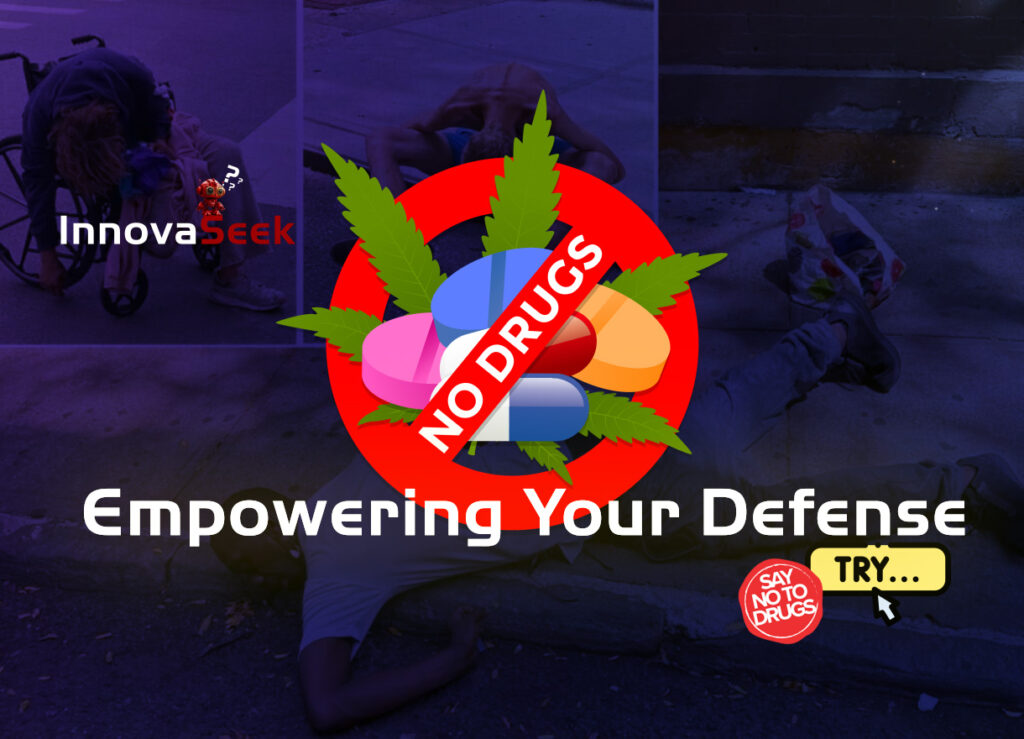Empowering Your Defense: Comprehensive Strategies to Protect Yourself from Drugs
Unlock key strategies, build resilience, and foster supportive environments to confidently navigate a drug-free life.

Key Insights for a Drug-Free Life
- Comprehensive Education: Understanding the specific dangers, health impacts, and long-term consequences of various drugs is foundational to prevention.
- Effective Refusal Skills: Developing and practicing confident “no” responses, combined with strategies to avoid high-pressure situations, are vital for personal safety.
- Holistic Well-being & Support Systems: Prioritizing mental and physical health, engaging in healthy activities, and fostering strong, supportive relationships are crucial protective factors.
Protecting yourself from drugs is a crucial aspect of maintaining overall health and well-being. This involves a multi-faceted approach that integrates education, personal resilience, and supportive social structures. The long-term consequences of drug use, including addiction, severe health issues, and strained relationships, underscore the importance of proactive prevention. By understanding the risks, developing robust refusal skills, managing stress effectively, and cultivating strong relationships, individuals can significantly reduce their vulnerability to drug involvement.

Understanding the Landscape of Drug Risks
A primary step in protecting oneself from drugs is to gain a thorough understanding of their dangers. This involves recognizing how substance abuse develops, the specific impacts of various substances, and the long-term consequences. Knowledge acts as a powerful deterrent, empowering individuals to make informed decisions.
The Perils of Substance Use
Drugs, whether illicit, prescription, or even over-the-counter when misused, can profoundly alter physical and mental health. Early exposure to drugs significantly increases the likelihood of addiction, as repeated use can fundamentally change brain chemistry, leading to dependency. For instance, synthetic opioids like fentanyl are exceptionally potent, with a minute amount capable of causing a fatal overdose.
Understanding these specific risks, such as the potential for liver injury from certain medications or the dangers of mixing drugs (polysubstance use), is critical. The adolescent brain, still undergoing rapid development, is particularly vulnerable to the damaging effects of alcohol and drugs.
Brain Changes and Addiction Pathways
Drug use, especially during developmental stages, can lead to significant alterations in brain structure and function. These changes can disrupt the brain’s reward system, making it difficult for individuals to experience pleasure from natural activities and leading to compulsive drug-seeking behaviors. The transition from voluntary drug use to addiction often involves these neurobiological adaptations, making recovery challenging but certainly achievable with professional support.
Mastering Refusal and Resilience Skills
Developing strong refusal skills is paramount for navigating social situations where drugs might be present. Coupled with personal resilience and self-esteem, these skills form a robust defense against peer pressure and temptation.
Tactics for Saying “No” Confidently
Confidently declining offers to use drugs is a skill that can be honed through practice. Here are several effective strategies:
- Direct Refusal: A simple and firm “No thanks” or “I’m not interested” can be highly effective.
- Giving an Excuse or Reason: Provide a clear, brief reason, such as “I have other plans,” “I need to stay clear-headed,” or “It’s not for me.”
- The “Broken Record” Approach: Calmly and repeatedly state your refusal until the pressure subsides. For example, “No, I’m not going to do that,” repeated as needed.
- Walking Away: If the pressure persists or the situation becomes uncomfortable, remove yourself from the environment.
- Changing the Subject: Redirect the conversation to a different topic, offering an alternative activity.
- Humor: A lighthearted or humorous response can sometimes diffuse a tense situation without being confrontational.
- Offering Alternative Activities: Suggesting something else to do, like going to a movie, playing video games, or engaging in a hobby, can shift the focus away from drug use.
Role-playing these scenarios can significantly bolster confidence in real-life situations. The key is to be prepared and assertive in your refusal.
Building Personal Confidence and Self-Esteem
A strong sense of self-worth acts as an internal shield against external pressures. Engaging in activities that build confidence, setting and achieving personal goals, and recognizing one’s value independent of substance use are crucial. Individuals with higher self-esteem are often better equipped to resist negative influences and make choices aligned with their long-term well-being.
Fostering a Supportive Environment
Beyond individual skills, the environment in which one operates plays a significant role in drug prevention. This includes surrounding oneself with positive influences, maintaining a balanced lifestyle, and accessing professional support when needed.
The Power of Positive Relationships
Surrounding yourself with family, friends, and mentors who encourage healthy choices provides invaluable emotional support and reinforcement. For young people, open and honest conversations with parents or trusted adults about the dangers of drugs, coupled with clear rules and consequences, can substantially reduce the likelihood of substance use. Parents serve as powerful role models, and their proactive discussions about the legal implications and health risks of drug use are highly effective.

Students participate in Red Ribbon Week, signifying their commitment to a drug-free life.
Engaging in Healthy Activities and Stress Management
Maintaining a balanced lifestyle with engaging hobbies, sports, and creative pursuits reduces idle time that could lead to risky situations. Healthy outlets for stress, such as yoga, meditation, journaling, or regular physical activity, can prevent individuals from resorting to drugs for relief. Identifying personal triggers for stress and developing constructive coping mechanisms are essential for emotional well-being and reducing vulnerability to substance use.
This mindmap illustrates the interconnected strategies for protecting oneself from drugs, emphasizing education, refusal skills, supportive environments, healthy lifestyles, and seeking help.
When to Seek Help: Resources and Support
Despite best prevention efforts, individuals may still find themselves or someone they know struggling with drug use. Knowing where to turn for help is a critical component of protection.
Professional Guidance and Treatment
Organizations such as SAMHSA (Substance Abuse and Mental Health Services Administration) offer confidential, 24/7 national helplines that provide information, treatment referrals, and support for individuals and families facing mental health and/or substance use disorders. Recovery from substance use disorder is a process that often involves addressing triggers, participating in treatment, engaging in aftercare programs, and joining support groups.
If you encounter someone under the influence who becomes aggressive, prioritizing your safety by removing yourself from the situation and seeking help from trusted individuals or authorities is crucial.
This radar chart illustrates the relative strength of various protective factors against drug use. A higher score (out of 5) indicates greater strength in that area. “Proactive Prevention” highlights the ideal state where protective factors are strong, while “Vulnerability Factors” represents a scenario where these defenses are weak.
This bar chart illustrates the perceived impact level (on a scale of 0 to 10) of various prevention strategies on an individual’s ability to protect themselves from drugs. Higher bars indicate a greater perceived positive influence on prevention.
Understanding Drug Prevention Through Visuals
This video provides an engaging and accessible explanation of how to say “no” to drugs, particularly tailored for a younger audience. It simplifies complex concepts of drug dangers and refusal skills, making them understandable and actionable. The video reinforces the importance of knowing what drugs are and how to respond when faced with peer pressure. This visual aid complements the comprehensive strategies discussed, providing a practical demonstration of refusal techniques and encouraging proactive decision-making from an early age.
Learn how to say no to drugs! A video for kids during Red Ribbon Week.
Holistic Prevention Strategies: A Comprehensive Overview
Effective drug prevention involves a layered approach that addresses individual behaviors, social influences, and environmental factors. By integrating multiple strategies, individuals can build a robust defense against drug involvement.
| Strategy Category | Key Actions and Benefits | Role in Prevention |
|---|---|---|
| Education & Awareness | Understanding drug effects, addiction mechanisms, and long-term consequences (e.g., altered brain chemistry, health issues like liver damage). | Empowers informed decision-making and fosters a deterrent mindset. |
| Refusal Skills Development | Practicing direct “no,” giving excuses, using the “broken record” technique, walking away, and offering alternatives. | Builds confidence to resist peer pressure and uncomfortable situations. |
| Stress Management & Coping | Engaging in healthy activities (yoga, meditation, hobbies), identifying triggers, and developing constructive emotional outlets. | Reduces reliance on substances for emotional relief and promotes mental well-being. |
| Building Supportive Relationships | Surrounding oneself with positive peers, maintaining open communication with family, and seeking mentorship. | Provides emotional support, encouragement, and a safe environment for healthy choices. |
| Setting Goals & Future Aspirations | Having clear personal goals and dreams that drugs would jeopardize. | Provides motivation to stay drug-free and reinforces positive life choices. |
| Limiting Exposure | Avoiding environments where drug use is prevalent and setting clear boundaries in social settings. | Minimizes opportunities and temptation for drug involvement. |
| Accessing Professional Help | Utilizing helplines (e.g., SAMHSA), prevention programs, and treatment referrals when struggling or concerned. | Offers crucial support, guidance, and pathways to recovery. |
This table summarizes the comprehensive strategies and their respective roles in protecting oneself from drug use. Each category contributes uniquely to building resilience and promoting a drug-free lifestyle.
Frequently Asked Questions (FAQ)
What are the immediate dangers of trying drugs for the first time?
Even a single use of certain drugs, particularly potent ones like fentanyl, can lead to severe health crises, overdose, or even death. Early use also significantly increases the risk of developing addiction due to rapid brain changes.
How can I help a friend who is struggling with drug use but refuses to admit it?
Approach your friend with empathy and concern, expressing your observations without judgment. Encourage them to seek professional help by providing resources like the SAMHSA National Helpline. Focus on your own safety and well-being first.
Are prescription drugs dangerous if misused?
Absolutely. Misusing prescription drugs, even those prescribed to you, can lead to addiction, overdose, and severe health consequences, including liver damage. Never share prescription medications or take them in a manner inconsistent with your doctor’s instructions.
What is the “broken record” technique for refusing drugs?
The “broken record” technique involves calmly and repeatedly stating your refusal without changing your stance or offering lengthy explanations. For example, consistently saying “No, I’m not going to do that” until the person stops pressuring you.
How important is family communication in preventing drug use?
Family communication is critically important. Open and honest discussions with parents or trusted adults about the dangers of drugs, setting clear rules, and establishing consequences can significantly reduce a young person’s likelihood of engaging in substance use. Parents also serve as vital role models.
Conclusion
Protecting oneself from drugs is an ongoing commitment that requires a proactive and informed approach. By prioritizing comprehensive education about the risks, mastering effective refusal skills, cultivating strong personal resilience, and fostering a supportive social environment, individuals can build a powerful defense against drug involvement. Furthermore, knowing when and where to seek professional help provides a critical safety net. Ultimately, prevention remains the most effective strategy, empowering individuals to make healthy choices and lead fulfilling, drug-free lives.
Recommended Further Exploration
- Understanding the neurological impacts of addiction
- Strategies for parents to discuss drug prevention with children
- Building resilience and coping mechanisms for stress
- Community-based drug prevention programs and their effectiveness
Referenced Search Results
samhsa.gov
National Helpline for Mental Health, Drug, Alcohol Issues | SAMHSA
grabellaw.com
How to Say NO to Drugs! – Grabel & Associates
georgiaaddictiontreatmentcenter.com
How to Avoid Drug Abuse – Georgia Addiction Treatment Center
nida.nih.gov
Preventing Drug Misuse and Addiction: The Best Strategy – National Institute on Drug Abuse (NIDA)
delcopa.gov
Tips for Prevention – Delaware County, PA
myhealth.alberta.ca
Saying No to Alcohol and Drugs – MyHealth Alberta
shrewsburyboro.com
9 ways to say “NO” to Drugs (PDF)
drugfree.org
Prevention Tips for Every Age – Partnership to End Addiction
Last updated June 13, 2025







